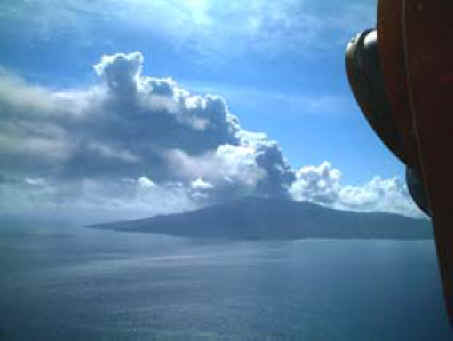
Miyakejima Volcano on the Izu Islands chain south of Tokyo,
Japan. Photo copyright S. Nakada, September 10,
2000. Twenty to fifty tons of sulfur dioxide gas per day are pouring from the caldera.
Below is a recent newspaper article about the people evacuated from the island.
Evacuated Islanders Long for Home
By JOJI SAKURAI
Copyright The Associated Press
TOKYO (AP) - Winter for Akira Tsumura was a time for rolling
over icy seas in pursuit of lobster and seaweed. Now, he's spending it huddled in a
government-provided shelter among the high-rises of Tokyo.
Tsumura is one of nearly 4,000 people forced by the reawakening
of a volcano last summer to evacuate Miyake Island, once a lush haven for rare birds and
mountain herbs, and a popular destination for divers and sport fishermen.
Six months later, it remains a no-man's land. The volcano is
still spewing ash and smoke, and no one knows when the islanders will be able to go home.
Government aid is running low. Lives are on hold.
``I'm happiest when I'm out on the sea and diving,'' the
52-year-old Tsumura said, chain-smoking in his cramped two-room apartment provided by the
Tokyo metropolitan government. ``It's different here. Even getting around and other daily
things leave me at a loss.''
The fate of the Miyake islanders, most of whom are in Tokyo
shelters, is in many ways a test of how much Japan has learned from the criticism that
followed botched relief efforts after the devastating 1995 earthquake in Kobe, western
Japan.
Not only did a late response to the quake by both local and
central government officials contribute heavily to the death toll of 6,400, but those left
homeless languished in shelters for years afterward with little help to rebuild their
lives.
It is a lesson Japan cannot afford to ignore.
Japan is dotted with active volcanoes and gridded with fault
lines that make it one of the most disaster-prone places in the world. Last year, two
eruptions caused mass evacuations, and a quake in southwest Japan damaged thousands of
homes.
Experts now are even worried Mount Fuji could erupt, forcing
millions to flee the Tokyo area.
Miyake's population was evacuated en masse last August after
Mount Oyama, the volcano that created the island in the seas just south of Tokyo, sent
huge plumes of smoke, gas and debris roiling into the sky. Oyama's last major eruption was
in 1983, when lava that flowed over its western flank demolished 500 homes.
This time, damage has been so severe the government has not yet
been able form a clear picture of its extent. Officials and scientists have visited the
island on fact-finding missions, but the islanders have been kept away.
Miyake residents are grateful for the free lodging and
government funds that provide daily sustenance. But they say the official approach is too
short-sighted.
Most of the islanders are self-employed, and they have taken
out huge loans to run their businesses. They will have to borrow more to start over.
Without jobs in Tokyo, interest is going unpaid.
``Even last night, just fretting and adding up all the bills in
my head I couldn't sleep,'' said Misao Aoyama, a 70-year-old vendor of kusaya, a pungent
dried fish that is a Miyake delicacy. ``Will I be able to pay off my debts?''
She says that if there is one thing she wishes she had taken
with her in the chaotic evacuation from the island, it's her address book. She feels
ashamed she couldn't send New Year's greetings to her friends.
But there's another thing she had to leave behind: Fish. Tens
of thousands of dollars worth of mackerel now rotting away in her freezer.
The central government has provided $9,000 in aid to each
Miyake household and the Tokyo city government is helping with $4,500 per family. That
money is barely enough to cover short-term expenses.
``I simply don't know what the solution to our problems will be
when we go back,'' Tsumura said. ``I want the government to give consideration to this.''
Tsumura, who ran a printing shop on Miyake and complemented his
income by fishing, says he may soon have to start thinking about finding work in Tokyo.
But as Japan's cash-strapped employers focus on slashing
workers rather than hiring them, people like Tsumura who have worked for themselves all
their lives have few prospects.
Minako Yamamoto, 48, said the listless life in Tokyo leaves a
lot of time to fret. At night, she has recurring nightmares of the mountain she once
thought of as a beloved friend.
``I run and run trying to escape the eruption, but can't,'' she
said.
Miyake's children have also suffered.
The evacuation took place in the middle of Japan's school year,
forcing Miyake's children to adjust to new curriculums and classmates while living in
government-run dormitories. Many graduated in April with little idea what to do with their
lives.
The government is providing little psychological care to ease
stress and depression. Tokyo officials admit one of their attempts at support, a telephone
counseling program, has been a failure.
``It's hardly being used,'' said Kenji Suzuki, the director of
Tokyo's disaster prevention division. ``People are simply unwilling to talk on the
phone.''
Suzuki said that though Tokyo has tried to learn from Kobe -
updating evacuation routes and stocking up on emergency water supplies - there is only so
much the government can do.
``Up to now the thinking has been that the administration is
responsible for protecting the people, but now we know that's not enough,'' he said. ``The
people have to protect themselves. That's the message we're trying to get out.''
Return
to Archive or go to Next Photo

